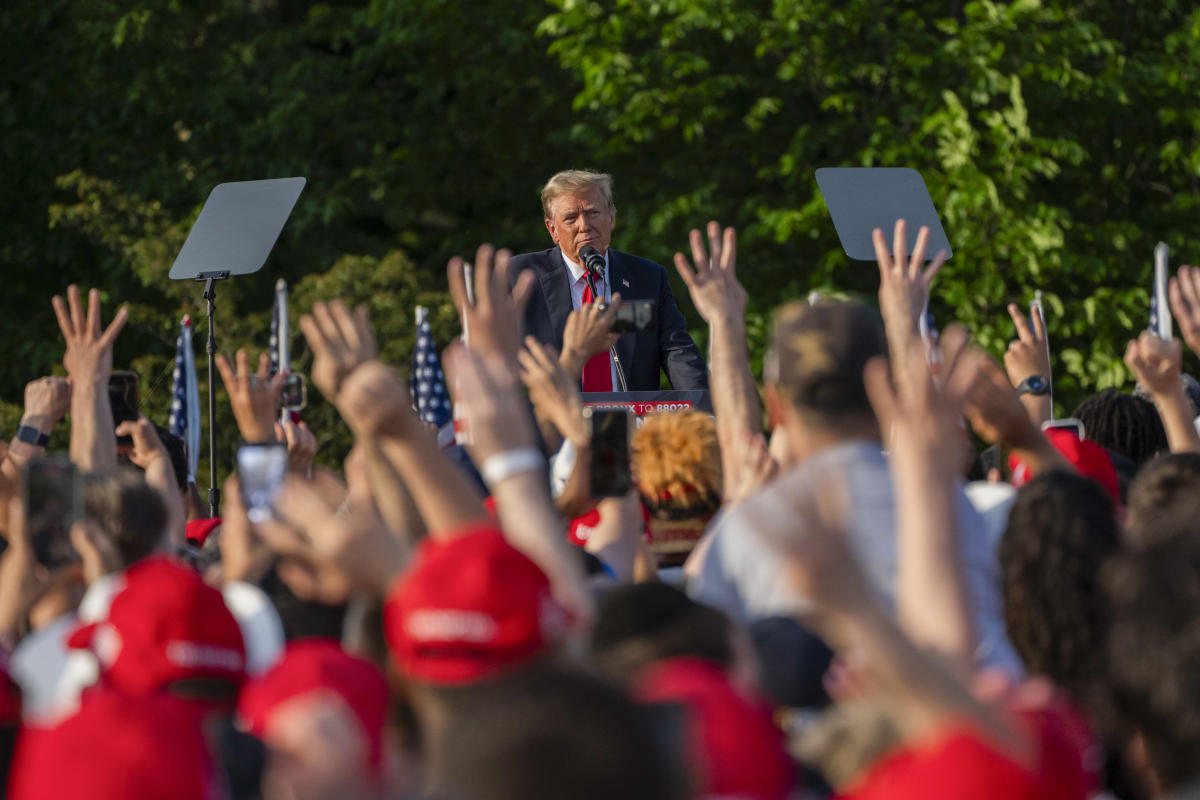NEW YORK – When his criminal trial ends today, Donald Trump will typically return to the marble and gold plywood atop Trump Tower, the high-rise he built in the early 1980s and used to build a public image as a master builder.
It’s the silver lining for Trump as he spends his first extended stint in Manhattan since moving to Washington in 2017. He spends his days in a dingy downtown courtroom, facing 34 felony charges, listening to people from his old life. describe him as a depraved liar who defiled the White House. Ultimately, he could be sent to prison.
Sign up for The Morning newsletter from the New York Times
But at night, people who have spoken to him say, he enjoys being back in the penthouse apartment he moved into 40 years ago. He still considers it his home – and a permanent reminder of the easiest period of his life.
That period was the greed-is-good era in which Trump sold himself nationally as an industrial titan despite a relatively small and local real estate portfolio. He had just built a magnificent tower on Fifth Avenue, which infuriated the elites and demanded a tax break from the city. And it’s the era he constantly refers to, citing cultural touchstones of the 1980s, including the news show “60 Minutes,” Time magazine and celebrities like boxer Mike Tyson.
It is also the last time Trump’s public image remained intact, and it soon collapsed. The decade ended with a months-long gossip war in which people in town took sides between him and his first wife, Ivana. At the same time, the image-obsessed Trump was the subject of one investigative story after another, revealing that he had far less money than it seemed, had relied on his father’s help and had led his empire to ruin.
It was in the 1980s that he publicly danced about whether he wanted to be accepted by the elites or throw stones at them, most visibly marked by his decision to smash Art Deco friezes that stood on top of the building he razed to build Trump. Tower.
But despite claims that the city’s powers that be were all mocking him, Trump was humored, conceded and even accepted by some of them. The ’80s were a time when, aided by his father’s connections in Brooklyn’s corrupt political machine, he developed relationships with publishing giants like SI Newhouse and hung out in the stadium box for New York club George Steinbrenner. Yankees owner.
Trump had begun a burgeoning and lasting partnership with one of the city’s power brokers, Manhattan District Attorney Robert Morgenthau, a man whose proximity gave Trump a sense of comfort, according to former Trump Organization employees, and whom Trump has said would never have stood for the charges against him.
“It’s absolutely true — that was undoubtedly his golden age,” said Andrew Stein, who was City Council president in the 1980s and still supports Trump after briefly suggesting he should sidestep his third presidential campaign.
Even being president — moving to a city and a world where the rules and laws were foreign and uninteresting to him, and where the establishment rejected him before he arrived — rarely seemed to please Trump as much as holding court at the 21 Club in the downtown Manhattan. did.
The trial has illuminated the parts of Trump’s character that became apparent in the decade that followed, the 1990s, and the parts that were less immediately visible after the fame brought to him by his ghostwritten 1987 book, The Art of the Deal’. The days in court have repeatedly spoken of his desire for revenge, his love of fixers to defend him, his obsession with being seen as a playboy, his business practices at what is essentially a mom-and-pop operation.
But they have also underscored the reality that a man who spent years building a ruse about himself in the press and on TV managed to win the presidency, when suddenly the question of which parts of him were real or fake was obscured by the power of the rulers. Oval Office, a massive government infrastructure and tens of millions of people who voted for him.
The era that shaped Trump was perhaps best summed up by author Tom Wolfe in “The Bonfire of the Vanities,” in which a wealthy investment banker beats a young black man during a hit-and-run in the Bronx amid widespread racial tensions. eventually tried in the flattened borough courthouse as the tabloids devoured the story.
It was a building similar to the one Trump occupied most days a week for six weeks, with fluorescent lights shining on the dilapidated pews and the letters “In God We Trust” above Judge Juan M. Merchan’s head stood.
Some days, Trump has eviscerated his lawyers and privately complained that he doesn’t have Roy Cohn, his original fixer, mentor and lawyer. Like Trump, Cohn was born into suburban privilege and then alternately reviled and accepted by powerful people. Cohn, a closeted gay man who tried to purge the federal government of gays, died in 1986; he had AIDS, but told people it was liver cancer.
Cohn, whose connections included President Ronald Reagan, Rupert Murdoch and gangsters, had introduced the Queens-bred Trump to a new world and taught him to always deny wrongdoing, attack his attackers and find lawyers willing to do anything . But by the early 1980s, as he began to gain prominence himself, Trump already seemed willing to put some distance between himself and Cohn.
“All I can tell you is that he has been cruel to others in his protection of me,” Trump told journalist Marie Brenner a few years before Cohn’s death. ‘He’s a genius. He’s a lousy lawyer, but he’s a genius.’
Trump essentially dropped Cohn, who had been repeatedly indicted, when he fell ill. It was later that Trump, despite his own criticism of his mentor, identified Cohn as the ideal that his other lawyers, including the new ones he dealt with in Washington, should aspire to.
Trump never spent much time in Trump Tower during his presidency. Most weekends he traveled to Mar-a-Lago, in Palm Beach, Florida, or to Bedminster, New Jersey. He said he avoided Manhattan because his motorcade would disrupt traffic. But Manhattan had rejected him at the ballot box. Residents had even laughed at him when he went to vote on Election Day in 2016; someone told him, “You’re going to lose!”
And so in September 2019, after consulting with his tax lawyers, Trump immediately rejected Manhattan and moved his residence to Florida. By the time he left office, a fortnight after an attack on the Capitol by a pro-Trump mob, he was all but done with his attempts to appease anyone other than himself.
This month, the former president and presumptive Republican nominee has tried to troll the city he left, showing that he can still dominate a place that still feels strange in the post-pandemic era.
On Thursday evening he held a meeting of thousands of people, not in Manhattan but in the Bronx. The event took place in a heavily black and Latino neighborhood, in a part of town where Trump attended Fordham University for two years and where Cohn’s former law partner was once the leader of the Democratic Party. Trump had suggested to donors at a fundraiser in Manhattan just days earlier that he might get hurt nearby, though he looked quite happy once he got there.
To cheers, he denounced transgender girls and women who participated in women’s sports. He attacked immigrants entering the U.S. illegally, whose increased use of city services was a flashpoint.
But the theme of his stories was the past. He talked about building Trump Tower, stating, “Wherever I go, I know if I could build a skyscraper in Manhattan, I could do anything.”
He lingered for a few minutes, describing how he rebuilt the defunct Wollman Rink in Central Park in 1986, a relatively small job that he nonetheless singled out for intense media attention. He described in detail the copper pipes that had been stolen and the concrete that had been wasted, and then he said that he had found a way to turn the rink into something else.
“The biggest cost was demolition,” Trump said of his work. “Just break it down and then start all over again.”
c.2024 The New York Times Company






